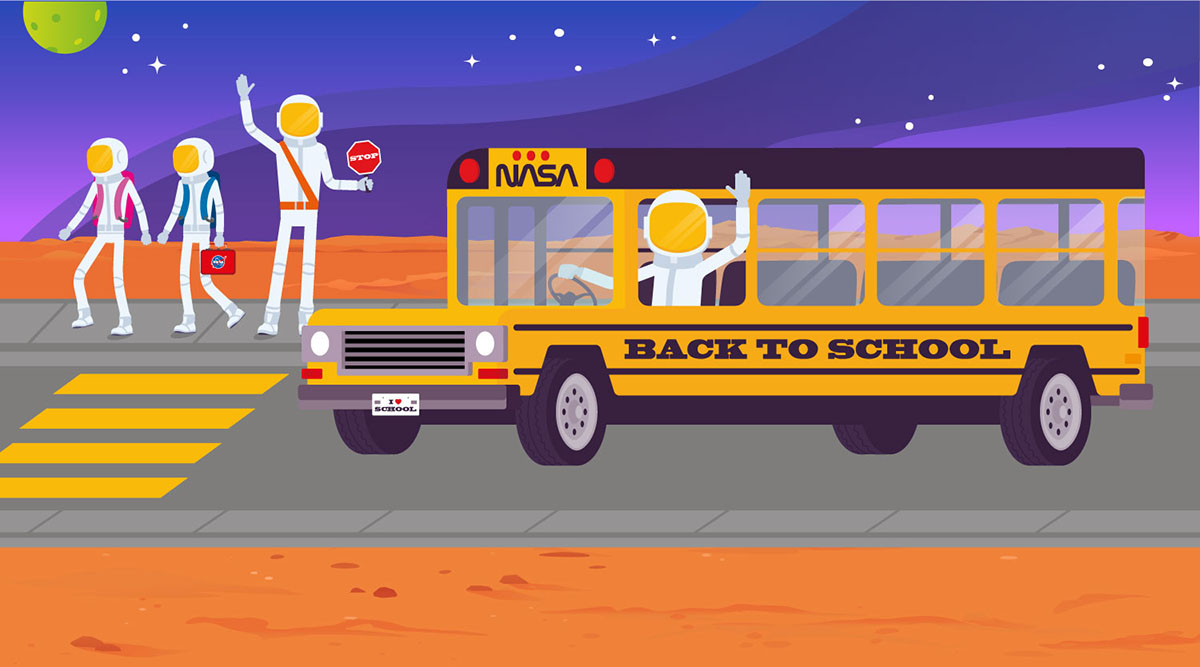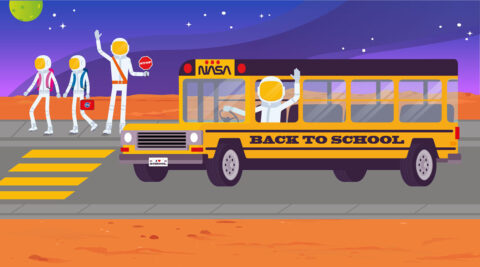 Washington, D.C. – With students across the country saying goodbye to the summer and the new school year is kicking off, NASA is gearing up to engage students in exciting activities and thought-provoking challenges throughout the year ahead.
Washington, D.C. – With students across the country saying goodbye to the summer and the new school year is kicking off, NASA is gearing up to engage students in exciting activities and thought-provoking challenges throughout the year ahead.
The agency offers many resources to inspire the next generation of explorers, and help educators and students stay involved in its missions.
“Back-to-school season is a really exciting time for NASA. It represents the beginning of a new year of opportunities to connect with students, and the families and teachers who support them,” said Mike Kincaid, associate administrator for NASA’s Office of STEM Engagement.
“We’re thrilled to be able to offer this variety of activities and options for students from K-12 to the collegiate level, whether they’re returning to a brick-and-mortar school or a virtual classroom at home,” Kincaid stated.
Below, NASA has prepared a long list of mission-related resources and opportunities for students, educators, and families to utilize during the 2021-2022 school year.
Follow NASA STEM on Twitter and Facebook social media channels using the hashtags #BacktoSchool and #NASASTEM for additional content and updates.
Artemis Missions
NASA’s Artemis missions will return humans to the Moon aboard the Orion spacecraft launched by the massive Space Launch System rocket. Artemis crews – including the first woman and first person of color to walk on the lunar surface – will use new technologies to explore our celestial neighbor. Lessons learned during the Artemis era will help us prepare to send astronauts to Mars.
NASA will launch this exciting new era starting with the uncrewed Artemis I mission later this year. Get started with ten ways for students to join Artemis, then learn more about Artemis I’s purposeful passenger, the Artemis Generation certificate, and the STEM Forward to the Moon activity guide.
High school and college students should check out NASA’s Artemis Student Challenges, engineering and technological design challenges focusing on topics and technologies involved in human spaceflight.
James Webb Space Telescope
The James Webb Space Telescope (also known as Webb) will be the largest, most powerful and complex space science telescope ever built by NASA. An Ariane 5 rocket provided by the European Space Agency will launch Webb in late 2021 from the European Spaceport located in Kourou, French Guiana.
The scientific successor to the enormously successful Hubble Space Telescope, Webb will use its advanced capabilities to peer even farther into the universe than its predecessor. NASA educational resources and art activities offer opportunities to learn more about how Webb can be used as a window into the universe’s past.
Educator resources are available for both formal and informal education, including comprehensive lesson plans and materials in the James Webb Space Telescope STEM toolkit. Kids also will enjoy the James Webb Fun Pad, a printable activity book designed for grades K-4.
Mars 2020: Perseverance and Ingenuity
The Mars 2020 Perseverance Rover successfully landed on the Red Planet’s surface in February 2021, and has begun its search for signs of ancient microbial life. As its mission continues, students and educators can utilize an array of NASA activities and resources to understand its operations and discoveries.
The Mission to Mars Student Challenge is designed to help educators lead students through the process of designing, building, launching, and landing a Mars mission. Students will apply their creativity, as well as science and math knowledge, to explore the Red Planet. Educators also are invited to explore the Mars 2020 STEM Toolkit and use the NASA Space Voyagers Card Game to design a planetary spacecraft.
Additional resources include the Mars 2020 landing toolkit, overviews of the Mars 2020 spacecraft and Mars helicopter, Mars 2020 mission images, and mission videos and animations.
Observing Earth
The NASA TechRise Student Challenge invites teams of students in grades 6 to 12 to design, build, and launch experiments on suborbital rockets and balloon flights during the school year. Participants will submit ideas for climate or remote-sensing experiments to fly on a high-altitude balloon, or space exploration experiments to fly aboard a suborbital rocket. Challenge details are available now; entries open August 18th.
Landsat 9 is the latest in the Landsat series of Earth-observing satellites that for decades have provided high-quality images and measurements – and a record of our ever-changing home planet. Landsat 9 is slated to launch in September 2021 aboard a United Launch Alliance Atlas V 401 rocket from Vandenberg Air Force Base in California.
Check out the Earth Observations STEMonstration to find out what astronauts see when they observe Earth from space.
Laser Communications Demo
Laser communications will revolutionize the way NASA sends and receives information to and from space. Using infrared light, laser communications will allow 10 to 100 times more data to be transmitted back to Earth than current radio frequency systems. Additionally, laser communications systems are smaller in size, weigh less, and require less power.
Launching later this year, Laser Communications Relay Demonstration (LCRD) will test out how the technology works more than 22,000 miles away from Earth. K-12 educators can teach students about laser communications using the LCRD STEM Launch Kit.
Crew Flights to the International Space Station
NASA is once again launching astronauts to the space station from American soil through the Commercial Crew Program. Both the Boeing Starliner and SpaceX Crew Dragon are designed to dock with the station, and now beginner and advanced student programmers can give it a try through the Crew Orbital Docking Simulation.
Additionally, anyone can get an immersive, behind-the-scenes look at astronaut training, spacecraft manufacturing facilities, and launch sites with 360-degree virtual reality tours – perfect for virtual class field trips!
K-12 educators are invited to explore more STEM resources at:
https://www.nasa.gov/stem/foreducators/k-12/index.html
For the latest NASA STEM events, activities, and news, visit:
https://stem.nasa.gov




